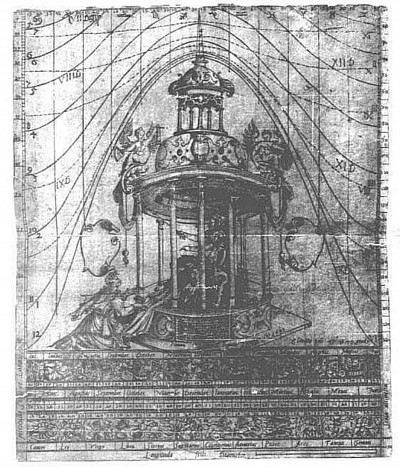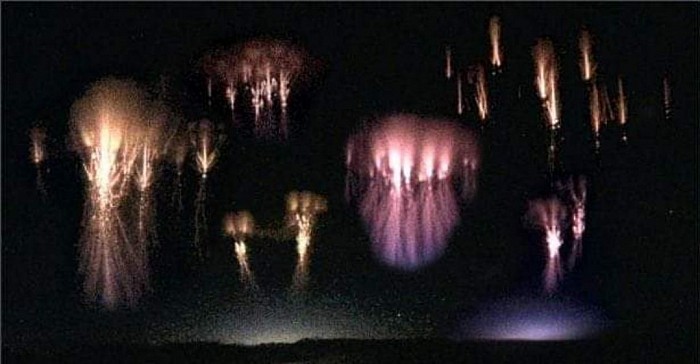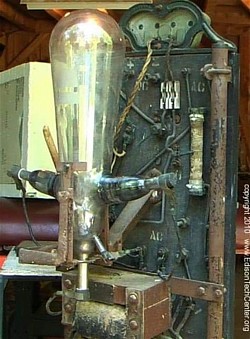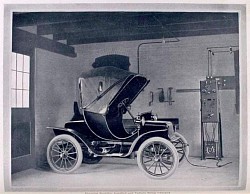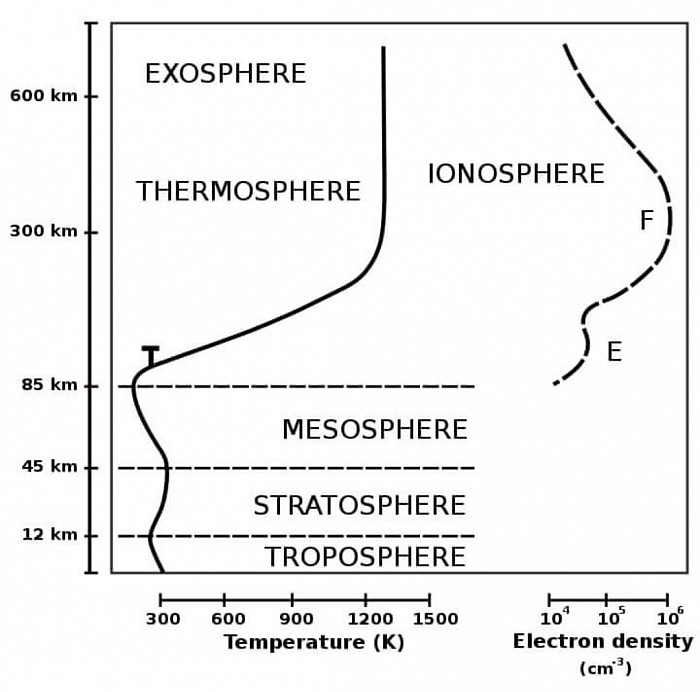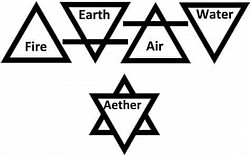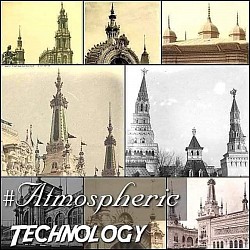FREE ENERGY
Aether
In physics, aether (also known as ether theories) propose the existence of a medium, a space-filling substance or field as a transmission medium for the propagation of electromagnetic or gravitational forces.
Since the development of special relativity, theories using a substantial aether fell out of use in modern physics, and are now replaced by more abstract models.
This early modern aether has little in common with the aether of classical elements from which the name was borrowed.
The assorted theories embody the various conceptions of this medium and substance.
🔻
Historical models
Isaac Newton suggests the existence of an aether in the Third Book of Opticks (1st ed. 1704; 2nd ed. 1718):
"Doth not this aethereal medium in passing out of water, glass, crystal, and other compact and dense bodies in empty spaces, grow denser and denser by degrees, and by that means refract the rays of light not in a point, but by bending them gradually in curve lines?
...Is not this medium much rarer within the dense bodies of the Sun, stars, planets and comets, than in the empty celestial space between them?
And in passing from them to great distances, doth it not grow denser and denser perpetually, and thereby cause the gravity of those great bodies towards one another, and of their parts towards the bodies; every body endeavouring to go from the denser parts of the medium towards the rarer?"
In the 19th century, luminiferous aether (or ether), meaning light-bearing aether, was a theorized medium for the propagation of light. James Clerk Maxwell developed a model to explain electric and magnetic phenomena using the aether, a model that led to what are now called Maxwell's equations and the understanding that light is an electromagnetic wave.
However, a series of increasingly complex experiments had been carried out in the late 1800s like the Michelson–Morley experiment in an attempt to detect the motion of Earth through the aether, and had failed to do so.
A range of proposed aether-dragging theories could explain the null result but these were more complex, and tended to use arbitrary-looking coefficients and physical assumptions.
Joseph Larmor discussed the aether in terms of a moving magnetic field caused by the acceleration of electrons.
Hendrik Lorentz and George Francis FitzGerald offered within the framework of Lorentz ether theory an explanation of how the Michelson–Morley experiment could have failed to detect motion through the aether. However, the initial Lorentz theory predicted that motion through the aether would create a birefringence effect, which Rayleigh and Brace tested and failed to find (Experiments of Rayleigh and Brace).
All of those results required the full application of the Lorentz transformation by Lorentz and Joseph Larmor in 1904.
Summarizing the results of Michelson, Rayleigh and others, Hermann Weyl would later write that the aether had "betaken itself to the land of the shades in a final effort to elude the inquisitive search of the physicist".
In addition to possessing more conceptual clarity, Albert Einstein's 1905 special theory of relativity could explain all of the experimental results without referring to an aether at all. This eventually led most physicists to conclude that the earlier notion of a luminiferous aether was not a useful concept.
🔻
Other models
In later years there have been a few individuals who advocated a neo-Lorentzian approach to physics, which is Lorentzian in the sense of positing an absolute true state of rest that is undetectable and which plays no role in the predictions of the theory.
(No violations of Lorentz covariance have ever been detected, despite strenuous efforts.)
Hence these theories resemble the 19th century aether theories in name only.
For example, the founder of quantum field theory, Paul Dirac, stated in 1951 in an article in Nature, titled "Is there an Aether?" that "we are rather forced to have an aether".
However, Dirac never formulated a complete theory, and so his speculations found no acceptance by the scientific community.
By contrast, at the very beginning of the 21st century, Dr. Charles Kenneth Thornhill outlined a non-singular ethereal cosmology in which he identified dark matter as ether - a medium pervading the universe, through which all electromagnetic waves and gravitational forces are propagated.
🔻
Quantum vacuum
Quantum mechanics can be used to describe spacetime as being non-empty at extremely small scales, fluctuating and generating particle pairs that appear and disappear incredibly quickly. It has been suggested by some such as Paul Diract hat this quantum vacuum may be the equivalent in modern physics of a particulate aether. However, Dirac's aether hypothesis was motivated by his dissatisfaction with quantum electrodynamics, and it never gained support from the mainstream scientific community.
🔻
Physicist Robert B. Laughlin wrote:
It is ironic that Einstein's most creative work, the general theory of relativity, should boil down to conceptualizing space as a medium when his original premise [in special relativity] was that no such medium existed [..]
The word 'ether' has extremely negative connotations in theoretical physics because of its past association with opposition to relativity.
This is unfortunate because, stripped of these connotations, it rather nicely captures the way most physicists actually think about the vacuum. . . .
Relativity actually says nothing about the existence or nonexistence of matter pervading the universe, only that any such matter must have relativistic symmetry. [..] It turns out that such matter exists.
About the time relativity was becoming accepted, studies of radioactivity began showing that the empty vacuum of space had spectroscopic structure similar to that of ordinary quantum solids and fluids.
Subsequent studies with large particle accelerators have now led us to understand that space is more like a piece of window glass than ideal Newtonian emptiness. It is filled with 'stuff' that is normally transparent but can be made visible by hitting it sufficiently hard to knock out a part.
The modern concept of the vacuum of space, confirmed every day by experiment, is a relativistic ether. But we do not call it this because it is taboo.
🔻
Pilot waves
Louis de Broglie stated, "Any particle, ever isolated, has to be imagined as in continuous "energetic contact" with a hidden medium."
However, as de Broglie pointed out, this medium "could not serve as a universal reference medium, as this would be contrary to relativity theory."
🔻
General relativity
Einstein's views on the aether
Albert Einstein sometimes used the word aether for the gravitational field within general relativity, but the only similarity of this relativistic aether concept with the classical aether models lies in the presence of physical properties in space, which can be identified through geodesics.
As historians such as John Stachel argue, Einstein's views on the "new aether" are not in conflict with his abandonment of the aether in 1905.
As Einstein himself pointed out, no "substance" and no state of motion can be attributed to that new aether.
Einstein's use of the word "aether" found little support in the scientific community, and played no role in the continuing development of modern physics.
🔻
Quantum electrodynamics
In particle physics, quantum electrodynamics (QED) is the relativistic quantum field theory of electrodynamics.
In essence, it describes how light and matter interact and is the first theory where full agreement between quantum mechanics and special relativity is achieved.
QED mathematically describes all phenomena involving electrically charged particles interacting by means of exchange of photons and represents the quantum counterpart of classical electromagnetism giving a complete account of matter and light interaction.
In technical terms, QED can be described as a perturbation theory of the electromagnetic quantum vacuum. Richard Feynman called it "the jewel of physics" for its extremely accurate predictions of quantities like the anomalous magnetic moment of the electron and the Lamb shift of the energy levels of hydrogen.
🔻
Luminiferous aether
Luminiferous aether or ether
("luminiferous", meaning "light-bearing") was the postulated medium for the propagation of light.
It was invoked to explain the ability of the apparently wave-based light to propagate through "empty space" (a vacuum), something that waves should not be able to do.
The assumption of a spatial plenum of luminiferous aether, rather than a spatial vacuum, provided the theoretical medium that was required by wave theories of light.
The aether hypothesis was the topic of considerable debate throughout its history, as it required the existence of an invisible and infinite material with no interaction with physical objects.
As the nature of light was explored, especially in the 19th century, the physical qualities required of an aether became increasingly contradictory. By the late 1800s, the existence of the aether was being questioned, although there was no physical theory to replace it.
🔻
The negative outcome of the Michelson–Morley experiment (1887)suggested that the aether did not exist, a finding that was confirmed in subsequent experiments through the 1920s.
This led to considerable theoretical work to explain the propagation of light without an aether.
A major breakthrough was the theory of relativity, which could explain why the experiment failed to see aether, but was more broadly interpreted to suggest that it was not needed.
The Michelson-Morley experiment, along with the blackbody radiator and photoelectric effect, was a key experiment in the development of modern physics, which includes both relativity and quantum theory, the latter of which explains the particle-like nature of light.
🔻
Particles vs. waves
Main article: Wave–particle duality
In the 17th century, Robert Boyle was a proponent of an aether hypothesis.
According to Boyle, the aether consists of subtle particles, one sort of which explains the absence of vacuum and the mechanical interactions between bodies, and the other sort of which explains phenomena such as magnetism (and possibly gravity) that are, otherwise, inexplicable on the basis of purely mechanical interactions of macroscopic bodies, "though in the ether of the ancients there was nothing taken notice of but a diffused and very subtle substance; yet we are at present content to allow that there is always in the air a swarm of steams moving in a determinate course between the north pole and the south".
Christiaan Huygens's Treatise on Light (1690) hypothesized that light is a wave propagating through an aether.
He and Isaac Newton could only envision light waves as being longitudinal, propagating like sound and other mechanical waves in fluids. However, longitudinal waves necessarily have only one form for a given propagation direction, rather than two polarizations like a transverse wave.
Thus, longitudinal waves can not explain birefringence, in which two polarizations of light are refracted differently by a crystal.
In addition, Newton rejected light as waves in a medium because such a medium would have to extend everywhere in space, and would thereby "disturb and retard the Motions of those great Bodies" (the planets and comets) and thus "as it [light's medium] is of no use, and hinders the Operation of Nature, and makes her languish, so there is no evidence for its Existence, and therefore it ought to be rejected".
Isaac Newton contended hat light is made up of numerous small particles.
This can explain such features as light's ability to travel in straight lines and reflect off surfaces.
Newton imagined light particles as non-spherical "corpuscles", with different "sides" that give rise to birefringence. But the particle theory of light can not satisfactorily explain refraction and diffraction.
To explain refraction, Newton's Third Book of Opticks (1st ed. 1704, 4th ed. 1730) postulated an "aethereal medium" transmitting vibrations faster than light, by which light, when overtaken, is put into "Fits of easy Reflexion and easy Transmission", which caused refraction and diffraction.
Newton believed that these vibrations were related to heat radiation:
Is not the Heat of the warm Room convey'd through the vacuum by the Vibrations of a much subtiler Medium than Air, which after the Air was drawn out remained in the Vacuum?
And is not this Medium the same with that Medium by which Light is refracted and reflected, and by whose Vibrations Light communicates Heat to Bodies, and is put into Fits of easy Reflexion and easy Transmission?
In contrast to the modern understanding that heat radiation and light are both electromagnetic radiation, Newton viewed heat and light as two different phenomena.
He believed heat vibrations to be excited "when a Ray of Light falls upon the Surface of any pellucid Body"
He wrote,
"I do not know what this Aether is", but that if it consists of particles then they must be expand itself...
🔻
End of aether
Aether theory was dealt another blow when the Galilean transformation and Newtonian dynamics were both modified by Albert Einstein's special theory of relativity, giving the mathematics of Lorentzian electrodynamics a new, "non-aether" context.
Unlike most major shifts in scientific thought, special relativity was adopted by the scientific community remarkably quickly, consistent with Einstein's later comment that the laws of physics described by the Special Theory were "ripe for discovery" in 1905.
Max Planck's early advocacy of the special theory, along with the elegant formulation given to it by Hermann Minkowski, contributed much to the rapid acceptance of special relativity among working scientists.
Einstein based his theory on Lorentz's earlier work. Instead of suggesting that the mechanical properties of objects changed with their constant-velocity motion through an undetectable aether, Einstein proposed to deduce the characteristics that any successful theory must possess in order to be consistent with the most basic and firmly established principles, independent of the existence of a hypothetical aether.
He found that the Lorentz transformation must transcend its connection with Maxwell's equations, and must represent the fundamental relations between the space and time coordinates of inertial frames of reference.
In this way he demonstrated that the laws of physics remained invariant as they had with the Galilean transformation, but that light was now invariant as well.
With the development of the special theory of relativity, the need to account for a single universal frame of reference had disappeared – and acceptance of the 19th-century theory of a luminiferous aether disappeared with it.
For Einstein, the Lorentz transformation implied a conceptual change: that the concept of position in space or time was not absolute, but could differ depending on the observer's location and velocity.
Moreover, in another paper published the same month in 1905, Einstein made several observations on a then-thorny problem, the photoelectric effect.
In this work he demonstrated that light can be considered as particles that have a "wave-like nature". Particles obviously do not need a medium to travel, and thus, neither did light.
This was the first step that would lead to the full development of quantum mechanics, in which the wave-like nature and the particle-like nature of light are both considered as valid descriptions of light.
A summary of Einstein's thinking about the aether hypothesis, relativity and light quanta may be found in his 1909 (originally German) lecture "The Development of Our Views on the Composition and Essence of Radiation".
Lorentz on his side continued to use the aether hypothesis. In his lectures of around 1911, he pointed out that what "the theory of relativity has to say ... can be carried out independently of what one thinks of the aether and the time". He commented that "whether there is an aether or not, electromagnetic fields certainly exist, and so also does the energy of the electrical oscillations" so that, "if we do not like the name of 'aether', we must use another word as a peg to hang all these things upon".
He concluded that "one cannot deny the bearer of these concepts a certain substantiality".
It should however be noted that on May 5th, 1920 Einstein gave an Address at the University of Leiden where he stated "More careful reflection teaches us however, that the special theory of relativity does not compel us to deny ether.
We may assume the existence of an ether; only we must give up ascribing a definite state of motion to it, i.e. we must by abstraction take from it the last mechanical characteristic which Lorentz had still left it.
We shall see later that this point of view, the conceivability of which I shall at once endeavour to make more intelligible by a somewhat halting comparison, is justified by the results of the general theory of relativity." and at the conclusion of his address states "Recapitulating, we may say that according to the general theory of relativity space is endowed with physical qualities; in this sense, therefore, there exists an ether.
According to the general theory of relativity space without ether is unthinkable;"
🔻
References
🔍
https://en.m.wikipedia.org/wiki/A_History_of_the_Theories_of_Aether_and_Electricity
🔎
https://en.m.wikipedia.org/wiki/Encyclop%C3%A6dia_Britannica_Ninth_Edition
🔻
https://web.archive.org/web/20051227132715/http://maxwell.byu.edu/~spencerr/phys442/history.pdf
🔍
https://en.m.wikipedia.org/wiki/Aether_theories
🔎
http://nobelprize.org/physics/laureates/1965/feynman-lecture.html
🔍
https://doi.org/10.1103%2FPhysRev.73.416
🔎
https://en.m.wikipedia.org/wiki/Quantum_electrodynamics
🔍
https://en.m.wikipedia.org/wiki/Electromagnetic_radiation
🔎
https://en.m.wikipedia.org/wiki/Luminiferous_aether
🔻
https://www.ams.org/journals/bull/1915-21-06/S0002-9904-1915-02631-5/S0002-9904-1915-02631-5.pdf
🔻
Vril
The Coming Race is a novel by Edward Bulwer-Lytton, published anonymously in 1871. It has also been published as Vril, the Power of the Coming Race.(Transhumanism)
Some readers have believed the account of a superior subterranean master race and the energy-form called "Vril", at least in part; some theosophists, notably Helena Blavatsky, William Scott-Elliot, and Rudolf Steiner, accepted the book as based on occult truth, in part.
One 1960 book.
Império Tártaro ®️
Cosmo-mechanic / Quantum / Aether
Controlling the quantum state The film bulk acoustic resonator was made of piezoelectric material, so that as it oscillated its changing shape created a changing electric signal, and conversely an electric signal could affect its oscillations.
This property enabled the resonator to be coupled with a superconducting phase qubit, a device used in quantum computing whose quantum state can be accurately controlled. In quantum mechanics, vibrations are made up of elementary vibrations called phonons.
Cooling the resonator to its ground state can be seen as equivalent to removing all of the phonons.
The team was then able to transfer individual phonons from the qubit to the resonator.
The team was also able to transfer a superposition state, where the qubit was in a superposition of two states at the same time, onto the mechanical resonator.
This means the resonator "literally vibrated a little and a lot at the same time", according to the American Association for the Advancement of Science.
The vibrations lasted just a few nanoseconds before being broken down by disruptive outside influences.
In the Nature paper, the team concluded "This demonstration provides strong evidence that quantum mechanics applies to a mechanical object large enough to be seen with the naked eye."
The Cosmos:
"The cosmos, and understandings of the reasons for its existence and significance, are studied in cosmology – a broad discipline covering scientific, religious or philosophical aspects of the cosmos and its nature. Religious and philosophical approaches may include the cosmos among spiritual entities or other matters deemed to exist outside the physical universe."
References
https://web.archive.org/web/20101219143542/http://cosmiclog.msnbc.msn.com/_news/2010/12/16/5660752-the-year-in-science-a-quantum-leap
https://www.newscientist.com/article/dn18669-first-quantum-effects-seen-in-visible-object.html
https://en.m.wikipedia.org/wiki/Quantum_machine http://www.nature.com/news/2010/100317/full/news.2010.130.html
https://en.m.wikipedia.org/wiki/Cosmos
Império Tártaro ®️
Upper-atmospheric lightning
Upper-atmospheric lightning or ionospheric lightning are terms sometimes used by researchers to refer to a family of short-lived electrical-breakdown phenomena that occur well above the altitudes of normal lightning and storm clouds.
Upper-atmospheric lightning is believed to be electrically induced forms of luminous plasma.
The preferred usage is transient luminous event (TLE), because the various types of electrical-discharge phenomena in the upper atmosphere lack several characteristics of the more familiar tropospheric lightning.
Transient luminous events have also been observed in far-ultraviolet images of Jupiter's upper atmosphere, high above the altitude of lightning-producing water clouds.
🔻
Characteristics
There are several types of TLEs, the most common being sprites. Sprites are flashes of bright red light that occur above storm systems. C-sprites (short for “columniform sprites”) is the name given to vertical columns of red light.
C-sprites exhibiting tendrils are sometimes called “carrot sprites”. Other types of TLEs include sprite halos, ghosts, blue jets, gigantic jets, pixies, gnomes, trolls, blue starters, and ELVESs.
The acronym ELVES (“Emission of Light and Very Low Frequency perturbations due to Electromagnetic Pulse Sources”) refers to a singular event which is commonly thought of as being plural. TLEs are secondary phenomena that occur in the upper atmosphere in association with underlying thunderstorm lightning.
TLEs generally last anywhere from less than a millisecond to more than 2 seconds. The first video recording of a TLE was captured accidentally on July 6, 1989 when researcher R.C Franz left a camera running overnight to view the night sky.
When reviewing the video taken, two finger-like vertical images appeared in two frames of the film. The next known video recordings of a TLE were taken in 1989, when the Shuttle Mission STS-34 was conducting the Mesoscale Lightning Observation Experiment.
On October 21, 1989 TLE'S were recorded during the Shuttle orbits 44 and 45. TLEs have been captured by a variety of optical recording systems, with the total number of recent recorded events (early 2009) estimated at many tens-of-thousands. The global rate of TLE occurrence has been estimated from satellite (FORMOSAT-2) observations to be several million events per year.
In the 1920s, the Scottish physicist C.T.R. Wilson predicted that electrical breakdown should occur in the atmosphere high above large thunderstorms.
In ensuing decades, high altitude electrical discharges were reported by aircraft pilots and discounted by meteorologists until the first direct visual evidence was documented in 1989. Several years later, the optical signatures of these events were named 'sprites' by researchers to avoid inadvertently implying physical properties that were, at the time, still unknown.
The terms red sprites and blue jets gained popularity after a video clip was circulated following an aircraft research campaign to study sprites in 1994.
🔻
Sprites
Sprites above Rome seen from Antibes - France
Sprites are large-scale electrical discharges which occur high above a thunderstorm cloud, or cumulonimbus, giving rise to a quite varied range of visual shapes.
They are triggered by the discharges of positive lightning between the thundercloud and the ground.
The phenomena were named after the mischievous sprite, e.g., Shakespeare's Ariel or Puck, and is also a bacronym for Stratospheric/mesospheric Perturbations Resulting from Intense Thunderstorm Electrification.
They normally are colored reddish-orange or greenish-blue, with hanging tendrils below and arcing branches above.
They can also be preceded by a reddish halo, known as a sprite halo. They often occur in clusters, lying 50 kilometres (31 mi) to 90 kilometres (56 mi) above the Earth's surface. Sprites have been witnessed thousands of times.
Sprites have been held responsible for otherwise unexplained accidents involving high altitude vehicular operations above thunderstorms.
🔻
Jets
Although jets are considered to be a type of upper-atmospheric lightning, it has been found that they are components of tropospheric lightning and a type of cloud-to-air discharge that initiates within a thunderstorm and travels upwards.
In contrast, other types of TLEs are not electrically connected with tropospheric lightning—despite being triggered by it. The two main types of jets are blue jets and gigantic jets.
Blue starters are considered to be a weaker form of blue jets.
🔻
Blue jets
Blue jets are believed to be initiated as "normal" lightning discharges between the upper positive charge region in a thundercloud and a negative "screening layer" present above this charge region.
The positive end of the leader network fills the negative charge region before the negative end fills the positive charge region, and the positive leader subsequently exits the cloud and propagates upward. It was previously believed that blue jets were not directly related to lightning flashes, and that the presence of hail somehow led to their occurrence.
They are also brighter than sprites and, as implied by their name, are blue in color.
The color is believed to be due to a set of blue and near-ultraviolet emission lines from neutral and ionized molecular nitrogen.
They were first recorded on October 21, 1989, on a monochrome video of a thunderstorm on the horizon taken from the Space Shuttle as it passed over Australia.
Blue jets occur much less frequently than sprites. By 2007, fewer than a hundred images had been obtained. The majority of these images, which include the first color imagery, are associated with a single thunderstorm.
🔻
Blue starters
Blue starters were discovered on video from a night time research flight around thunderstorms and appear to be "an upward moving luminous phenomenon closely related to blue jets."
They appear to be shorter and brighter than blue jets, reaching altitudes of only up to 20 km.
"Blue starters appear to be blue jets that never quite make it," according to Dr. Victor P. Pasko, associate professor of electrical engineering.
🔻
Gigantic jets
Where blue jets are believed to initiate between the upper positive charge region and a negative screening layer directly above this region, gigantic jets appear to initiate between the upper positive and lower negative charge regions in the thundercloud.
In a similar process to how blue jets form, the higher charge region is discharged by the leader network before the same occurs in the lower charge region, and one end of the leader network propagates upward from the cloud toward the ionosphere. Gigantic jets reach higher altitudes than blue jets, and the upper portion of the jet changes color from blue to red.
🔻
ELVES
ELVES (Emission of Light and Very Low Frequency perturbations due to Electromagnetic Pulse Sources) often appear as a dim, flattened, expanding glow around 400 km (250 mi) in diameter that lasts for, typically, just one millisecond.
They occur in the ionosphere 100 km (62 mi) above the ground over thunderstorms. Their color was unknown for some time, but is now believed to be red. ELVES were first recorded on another shuttle mission, this time recorded off French Guiana on October 7, 1990.
That ELVES was discovered in the Shuttle Video by the Mesoscale Lightning Experiment (MLE) team at Marshall Space Flight Center, AL led by the Principal Investigator, Otha H."Skeet" Vaughan, Jr.
ELVES is a whimsical acronym for Emissions of Light and Very Low Frequency Perturbations due to Electromagnetic Pulse Sources.
This refers to the process by which the light is generated; the excitation of nitrogen molecules due to electron collisions (the electrons possibly having been energized by the electromagnetic pulse caused by a discharge from an underlying thunderstorm).
🔎
Trolls, Pixies, Ghosts, and Gnomes
🔻
TROLLs
(Transient Red Optical Luminous Lineaments) occur after strong sprites, and appear as red spots with faint tails, and on higher-speed cameras, appear as a rapid series of events, starting as a red glow that forms after a sprite tendril, that later produces a red streak downward from itself. They are similar to jets.
🔻
Pixies
Pixies were first observed during the STEPS program during the summer of 2000, a multi-organizational field program investigating the electrical characteristics over thunderstorms on the High Plains. A series of unusual, white luminous events atop the thunderstorm were observed over a 20-minute period, lasting for an average of 16 milliseconds each.
They were later dubbed 'pixies'. They are less than 100 meters across. They are not related to lightning.
🔻
Ghosts
Ghosts (Green emissions from excited Oxygen in Sprite Tops) are faint, green glows that appear after red sprites, fading away in milliseconds.
While they were initially documented by photographer Randy Halverson in 2014, Ghosts were officially discovered by professional storm chaser Hank Schyma and Paul M Smith in 2019.
No scientific journals exist on these phenomena yet due to their recent classification as a unique Upper-atmospheric phenomenon, but they have been observed on footage.
Their green glow has been hypothesized by its observers to come from excited oxygen atoms, much as how auroras appear green, however, this is unconfirmed.
🔻
Gnomes
Gnomes are small, brief spikes of light that point upward from a thunderstorm cloud's anvil top, caused as strong updrafts push moist air above the anvil. They last for only a few microseconds.
They are about 200 meters wide, and are a maximum of 1 kilometer in height. Their color is unknown as they have only been observed in black-and-white footage.
🔻
References / Source
🔎
http://www.eurosprite.net/
🔎
https://web.archive.org/web/20070513120802/http://www-star.stanford.edu/~vlf/optical/press/elves97sciam/
🔎
https://ztresearch.blog/education/cloud-flashes/
🔎
https://web.archive.org/web/20080607021834/http://band.unk.edu/src/naturearticle.html
🔎
https://en.m.wikipedia.org/wiki/Upper-atmospheric_lightning
🔻
Sprite (lightning)
Sprites or red sprites are large-scale electric discharges that occur high above thunderstorm clouds, or cumulonimbus, giving rise to a varied range of visual shapes flickering in the night sky.
They are usually triggered by the discharges of positive lightning between an underlying thundercloud and the ground.
Sprites appear as luminous red-orange flashes. They often occur in clusters above the troposphere at an altitude range of 50–90 km (31–56 mi). Sporadic visual reports of sprites go back at least to 1886 but they were first photographed on July 4, 1994, by scientists from the University of Minnesota and have subsequently been captured in video recordings many thousands of times.
Sprites are sometimes inaccurately called upper-atmospheric lightning. However, sprites are cold plasma phenomena that lack the hot channel temperatures of tropospheric lightning, so they are more akin to fluorescent tube discharges than to lightning discharges. Sprites are associated with various other upper-atmospheric optical phenomena including blue jets and ELVES.
🔻
History
The earliest known report of transient optical phenomena above thunderclouds is from Johann Georg Estor in 1730. Another early report is by Toynbee and Mackenzie in 1886.
Nobel laureate C. T. R. Wilson had suggested in 1925, on theoretical grounds, that electrical breakdown could occur in the upper atmosphere, and in 1956 he witnessed what possibly could have been a sprite.
They were first documented photographically on July 6, 1989, when scientists from the University of Minnesota, using a low-light video camera, accidentally captured the first image of what would subsequently become known as a sprite.
Several years after their discovery they were named sprites (air spirits) after their elusive nature.
Since the 1989 video capture, sprites have been imaged from the ground, from aircraft and from space, and have become the subject of intensive investigations.
In 2016, sprites were observed during Hurricane Matthew's passage through the Caribbean.
The role of sprites in the tropical cyclones is presently unknown.
Sprites have been observed over North America, Central America, South America, Europe, Central Africa (Zaire), Australia, the Sea of Japan and Asia and are believed to occur during most large thunderstorm systems.
Rodger (1999) categorized three types of sprites based on their visual appearance.
Jellyfish sprite – very large, up to 50 by 50 km (31 by 31 mi).
Column sprite (C-sprite) – large scale electrical discharges above the earth that are still not totally understood.
Carrot sprite – a column sprite with long tendrils.
Sprites are colored reddish-orange in their upper regions, with bluish hanging tendrils below, and can be preceded by a reddish halo. They last longer than normal lower stratospheric discharges, which last typically a few milliseconds, and are usually triggered by the discharges of positive lightning between the thundercloud and the ground, although sprites generated by negative ground flashes have also been observed.
They often occur in clusters of two or more, and typically span the altitude range 50 to 90 kilometres (31 to 56 mi), with what appear to be tendrils hanging below, and branches reaching above.
Sprites are sometimes preceded, by about 1 millisecond, by a sprite halo, a pancake-shaped region of weak, transient optical emissions approximately 50 kilometres (31 mi) across and 10 kilometres (6.2 mi) thick.
The halo is centered at about 70 kilometres (43 mi) altitude above the initiating lightning strike.
These halos are thought to be produced by the same physical process that produces sprites, but for which the ionization is too weak to cross the threshold required for streamer formation. They are sometimes mistaken for ELVES, due to their visual similarity and short duration.
Research carried out at Stanford University in 2000 indicates that, unlike sprites with bright vertical columnar structure, occurrence of sprite halos is not unusual in association with normal (negative) lightning discharges.
Research in 2004 by scientists from Tohoku University found that very low frequency emissions occur at the same time as the sprite, indicating that a discharge within the cloud may generate the sprite.
🔻
References
🔎
http://www.uh.edu/research/spg/Sprites99.html
🔎
http://petapixel.com/2013/06/03/photographer-captures-rare-photograph-of-a-sprite-with-an-aurora/
🔎
http://spaceweathergallery.com/indiv_upload.php?upload_id=150878&PHPSESSID=6u1kp82m1grck1i84qeiu39im0
🔎
https://en.m.wikipedia.org/wiki/Sprite_(lightning)
Learn more
🔻
Plasma (physics)
Plasma (from Ancient Greek πλάσμα (plásma) 'moldable substance') is one of the four fundamental states of matter.
It contains a significant portion of charged particles – ions and/or electrons.
The presence of these charged particles is what primarily sets plasma apart from the other fundamental states of matter. It is the most abundant form of ordinary matter in the universe, being mostly associated with stars, including the Sun.
It extends to the rarefied intracluster medium and possibly to intergalactic regions.
Plasma can be artificially generated by heating a neutral gas or subjecting it to a strong electromagnetic field.
The presence of charged particles makes plasma electrically conductive, with the dynamics of individual particles and macroscopic plasma motion governed by collective electromagnetic fields and very sensitive to externally applied fields.
The response of plasma to electromagnetic fields is used in many modern technological devices, such as plasma televisions or plasma etching.
Depending on temperature and density, a certain amount of neutral particles may also be present, in which case plasma is called partially ionized. Neon signs and lightning are examples of partially ionized plasmas.
Unlike the phase transitions between the other three states of matter, the transition to plasma is not well defined and is a matter of interpretation and context.
Whether a given degree of ionization suffices to call a substance 'plasma' depends on the specific phenomenon being considered.
🔻
References
🔎
http://c3po.barnesos.net/homepage/lpl/grapeplasma/
🔎
http://comphys.narod.ru/
🔎
https://en.m.wikipedia.org/wiki/Plasma_(physics)
Império Tártaro ®️
Mercury Vapor (or Arc) Rectifiers.
-The terms vapor or arc as applied to rectifiers, do not indicate a different principle; the Westinghouse Co.employ the former term and the General rectifier connections.
A.A., graphite an- odes; B, mercury cathode; C, small starting electrode; D, battery connection; E and F, reactance coils; G and H. transformer terminals; J. battery.
The small starting electrode. C. is connected to one side of the a.c. circuit, through resistance; and by rocking the tube, a slight arc is formed, which starts the operation of the rectifier tube.
At the instant the terminal H. of the supply transformer is positive, the anode A, is then positive, and the are is free to flow between A and B.
Following the direction of the arrow still further, the current passes through the battery J., through one-half of the main reactance coil E, and back to the negative terminal G, of the transformer.
When the impressed voltage falls below a value sufficient to maintain the arc against the reverse pressure of the are and load. the reactance E, which heretofore has been charging, now discharges, the discharge current being in the same direction as formerly.
This serves to maintain the are in the rectifier tube until the pressure of the supply has passed through zero, reversed, and built up such value as to cause the anode A, to have a sufficiently positive value to start the are between it and the cathode B.
The discharge circuit of the reactance coil E, is now through the aro A'B, instead of through its former circuit. Consequently the arc A'B, is now supplied with current, partly from the transformer, and partly from the reactance coil E. The new cir cuit from the transformer is indicated by the arrows enclosed in circles, are dissolved place the cover in position.
The specific gravity of the solution should be 1.125. The middle iron electrode must hang straight down in the solution and not touch either of the other aluminum alloy electrodes.
The aluminum alloy electrodes are mounted on an insulated bracket that slides up and down on a rod.
This rod screws in the hose taped in the middle of the cover.
The electrodes give the best results only when per fectly smooth. Should they get rough, covered with a deposit or a white coating remove from the solution, and clean with fine sand paper. Finish with fine sand paper. Form the film again and the electrodes will be as good as new.
Clean iron electrode occasionally.
Electric Co., the latter as a distinguishing title or trade mark. Fig. 6,621 is an elementary diagram of a mercury arc rectifier and its operation is explained fully under the illustration.
In used, but they are not because, on account of the arc produced, they would gradually wear away and could not be conveniently replaced.
In operation The heat generated in the bulb is dissipated through the tube to the air, large tubes being submerged in a tank of oil.
Fios. 6,622 to 6,624.-General Electric mercury are rectifier outfit, or charging set.
The cut shows front, rear, and side views of the rectifier, illustrating the arrangement on a panel of the rectifier tube with its connection and operating devices.
To start the rectifier, close in order named line switch and circuit breaker; hold the starting switch in opposite position from normal; rock the tube gently by rectifier shaker.
When the tube starts, as hown by greenish blue light, release starting switch and see that it goes back to normal position.
Adjust the charging current by means of fine regulation switch on the left; or, not sufficient, by one button of course regulation switch on the right.
The regulating witch may have to be adjusted occasionally during charge, if it be desired to maintain charging amperes approximately constant.
An inherent defect of mercury rectifiers is the reverse pressure of about 14 volts produced by the arc and which remains nearly constant for all loads, resulting in decrease in commercial efficiency on light loads.
Higher efficiency and lower first cost.
https://m.facebook.com/story.php?story_fbid=494667252663984&id=100063621404429
Império Tártaro ®️
Subcategories: This category has the following 3 subcategories, out of 3 total. C Mercury-arc rectifier circuits (2 F) E Efficiency of a mercury arc rectifier for charging storage batteries (1909) (8 F) I Ignitron (9 F) Video https://www.facebook.com/watch/?v=1101049633705763 Media in category "Mercury arc rectifiers"
"The 5th Element" A mercury-arc valve or mercury-vapor rectifier or (UK) mercury-arc rectifier is a type of electrical rectifier used for converting high-voltage or high-current alternating current (AC) into direct current (DC). It is a type of cold cathode gas-filled tube, but is unusual in that the cathode, instead of being solid, is made from a pool of liquid mercury and is therefore self-restoring. As a result, mercury-arc valves were much more rugged and long-lasting, and could carry much higher currents than most other types of gas discharge tube. Mercury rectifier on display in the Beromünster AM transmitter in Switzerland, before being decommissioned. Three-phase full-wave rectifier with six anodes.
RECTIFIERS 191-3,551 Electric Co., the latter as a distinguishing title or trade mark. Fig. 6,621 is an elementary diagram of a mercury arc rectifier and its operation is explained fully under the illustration. In the manufacture of rectifiers, other metals than mercury could be used, but they are not because, on account of the arc produced, they would gradually wear away and could not be conveniently replaced. In operation the heat generated in the bulb is dissipated through the tube to the air. Fios. 6,622 to 6,624. -General Electric mercury are rectifier outfit, or charging set. The cut shows front, rear, and side views of the rectifier, illustrating the arrangement on a panel of the rectifier tube with its connection and operating devices. To start the rectifier, close in order named line switch and circuit breaker; hold the starting switch in opposite position from normal; rock the tube gently by rectifier shaker. When the tube starts, as hown by greenish blue light, release starting switch and see that it goes back to normal position. Adjust the charging current by means of fine regulation switch on the left; or, not sufficient, by one button of course regulation switch on the right. The regulating witch may have to be adjusted occasionally during charge, if it be desired to maintain charging amperes approximately constant. An inherent defect of mercury rectifiers is the reverse pressure of about 14 volts produced by the arc and which remains nearly constant for all loads, resulting in decrease in commercial efficiency on light loads. Higher efficiency and lower first cost! Read Content 👇 https://m.facebook.com/story.php?story_fbid=363486872448690&id=100063621404429 Império Tártaro ®️
Ionosphere
The ionosphere
- is the ionized part of Earth's upper atmosphere, from about 48 km (30 mi) to 965 km (600 mi) altitude, a region that includes the thermosphere and parts of the mesosphere and exosphere.
The ionosphere is ionized by solar radiation. It plays an important role in atmospheric electricity and forms the inner edge of the magnetosphere.
It has practical importance because, among other functions, it influences radio propagation to distant places on the Earth.
🔻
Geophysics
The ionosphere is a shell of electrons and electrically charged atoms and molecules that surrounds the Earth, stretching from a height of about 50 km (30 mi) to more than 1,000 km (600 mi). It exists primarily due to ultraviolet radiation from the Sun.
The lowest part of the Earth's atmosphere, the troposphere extends from the surface to about 10 km (6 mi).
Above that is the stratosphere, followed by the mesosphere. In the stratosphere incoming solar radiation creates the ozone layer.
At heights of above 80 km (50 mi), in the thermosphere, the atmosphere is so thin that free electrons can exist for short periods of time before they are captured by a nearby positive ion. The number of these free electrons is sufficient to affect radio propagation. This portion of the atmosphere is partially ionized and contains a plasma which is referred to as the ionosphere.
Ultraviolet (UV), X-ray and shorter wavelengths of solar radiation are ionizing, since photons at these frequencies contain sufficient energy to dislodge an electron from a neutral gas atom or molecule upon absorption.
In this process the light electron obtains a high velocity so that the temperature of the created electronic gas is much higher (of the order of thousand K) than the one of ions and neutrals. The reverse process to ionization is recombination, in which a free electron is "captured" by a positive ion.
Recombination occurs spontaneously, and causes the emission of a photon carrying away the energy produced upon recombination.
As gas density increases at lower altitudes, the recombination process prevails, since the gas molecules and ions are closer together. The balance between these two processes determines the quantity of ionization present.
Ionization depends primarily on the Sun and its activity. The amount of ionization in the ionosphere varies greatly with the amount of radiation received from the Sun. Thus there is a diurnal (time of day) effect and a seasonal effect.
The local winter hemisphere is tipped away from the Sun, thus there is less received solar radiation. The activity of the Sun modulates following the solar cycle, with more radiation occurring with more sunspots, with a periodicity of around 11 years.
Radiation received also varies with geographical location (polar, auroral zones, mid-latitudes, and equatorial regions).
There are also mechanisms that disturb the ionosphere and decrease the ionization.
There are disturbances such as solar flares and the associated release of charged particles into the solar wind which reaches the Earth and interacts with its geomagnetic field.
Sydney Chapman proposed that the region below the ionosphere be called neutrosphere
(the neutral atmosphere).
🔻
Other application:
The open system electrodynamic tether, which uses the ionosphere, is being researched. The space tether uses plasma contactors and the ionosphere as parts of a circuit to extract energy from the Earth's magnetic field by electromagnetic induction.
Electromagnetic or magnetic induction is the production of an electromotive force across an electrical conductor in a changing magnetic field.
Alternating electric current flows through the solenoid on the left, producing a changing magnetic field. This field causes, by electromagnetic induction, an electric current to flow in the wire loop.
🔻
References
🔍
https://archive.org/details/trent_0116300004144
🔎
https://www.britannica.com/eb/article-9042708/ionosphere-and-magnetosphere
🔍
https://en.m.wikipedia.org/wiki/Electromagnetic_induction
🔎
https://en.m.wikipedia.org/wiki/Ionosphere
🔍
https://archive.org/details/atreatiseonelec04maxwgoog
🔎
https://www.amazon.com/exec/obidos/tg/detail/-/0132413264/ref=ord_cart_shr?%5Fencoding=UTF8&m=ATVPDKIKX0DER&v=glance
🔍
http://web.hep.uiuc.edu/home/serrede/P435/Lecture_Notes/A_Brief_History_of_Electromagnetism.pdf
Império Tártaro ®️
https://www.facebook.com/Historia.apagada
Cathode
A cathode is the electrode from which a conventional current leaves a polarized electrical device. This definition can be recalled by using the mnemonic CCD for Cathode Current Departs. A conventional current describes the direction in which positive charges move. Electrons have a negative electrical charge, so the movement of electrons is opposite to that of the conventional current flow. Consequently, the mnemonic cathode current departs also means that electrons flow into the device's cathode from the external circuit.
The electrode through which conventional current flows the other way, into the device, is termed an anode.
Conventional current flows from cathode to anode outside of the cell or device (with electrons moving in the opposite direction), regardless of the cell or device type and operating mode.
Cathode polarity with respect to the anode can be positive or negative depending on how the device is being operated. Positively charged cations always move towards the cathode and negatively charged anions move towards the anode, although cathode polarity depends on the device type, and can even vary according to the operating mode.
In a device which absorbs energy of charge (such as recharging a battery), the cathode is negative (electrons flow out of the cathode, and positive charge flows into it), and in a device which provides energy (such as battery in use), the cathode is positive (electrons flow into it and charge flows out):
A battery or galvanic cell in use has a cathode that is the positive terminal since that is where the current flows out of the device. This outward current is carried internally by positive ions moving from the electrolyte to the positive cathode (chemical energy is responsible for this "uphill" motion). It is continued externally by electrons moving into the battery which constitutes positive current flowing outwards.
For example, the Daniell galvanic cell's copper electrode is the positive terminal and the cathode. A battery that is recharging or an electrolytic cell performing electrolysis has its cathode as the negative terminal, from which current exits the device and returns to the external generator as charge enters the battery/ cell. For example, reversing the current direction in a Daniell galvanic cell converts it into an electrolytic cell where the copper electrode is the positive terminal and also the anode. In a diode, the cathode is the negative terminal at the pointed end of the arrow symbol, where current flows out of the device. Note: electrode naming for diodes is always based on the direction of the forward current (that of the arrow, in which the current flows "most easily"), even for types such as Zener diodes or solar cells where the current of interest is the reverse current. In vacuum tubes (including cathode ray tubes) it is the negative terminal where electrons enter the device from the external circuit and proceed into the tube's near-vacuum, constituting a positive current flowing out of the device.
The word was coined in 1834 from the Greek κάθοδος (kathodos), 'descent' or 'way down', by William Whewell, who had been consulted by Michael Faraday over some new names needed to complete a paper on the recently discovered process of electrolysis.
In that paper Faraday explained that when an electrolytic cell is oriented so that electric current traverses the "decomposing body" (electrolyte) in a direction "from East to West, or, which will strengthen this help to the memory, that in which the sun appears to move", the cathode is where the current leaves the electrolyte, on the West side: "kata downwards, `odos a way ; the way which the sun sets".
The use of 'West' to mean the 'out' direction (actually 'out' → 'West' → 'sunset' → 'down', i.e. 'out of view') may appear unnecessarily contrived. Previously, as related in the first reference cited above, Faraday had used the more straightforward term "exode" (the doorway where the current exits).
His motivation for changing it to something meaning 'the West electrode' (other candidates had been "westode", "occiode" and "dysiode") was to make it immune to a possible later change in the direction convention for current, whose exact nature was not known at the time. The reference he used to this effect was the Earth's magnetic field direction, which at that time was believed to be invariant.
He fundamentally defined his arbitrary orientation for the cell as being that in which the internal current would run parallel to and in the same direction as a hypothetical magnetizing current loop around the local line of latitude which would induce a magnetic dipole field oriented like the Earth's.
This made the internal current East to West as previously mentioned, but in the event of a later convention change it would have become West to East, so that the West electrode would not have been the 'way out' any more. Therefore, "exode" would have become inappropriate, whereas "cathode" meaning 'West electrode' would have remained correct with respect to the unchanged direction of the actual phenomenon underlying the current, then unknown but, he thought, unambiguously defined by the magnetic reference. In retrospect the name change was unfortunate, not only because the Greek roots alone do not reveal the cathode's function any more, but more importantly because, as we now know, the Earth's magnetic field direction on which the "cathode" term is based is subject to reversals whereas the current direction convention on which the "exode" term was based has no reason to change in the future.
Since the later discovery of the electron, an easier to remember, and more durably technically correct (although historically false), etymology has been suggested: cathode, from the Greek kathodos, 'way down', 'the way (down) into the cell (or other device) for electrons'.
More info 👇
https://en.m.wikipedia.org/wiki/Cathode
Sine wave generators.
Alternating electrical current (AC), which is available from wall outlets in most places, alternates in a sine wave pattern at 60 cycles per second (Hertz).
A sine wave is characterized by continuous, uniform oscillation that can be represented as a series of "hills" and "valleys" with perfect proportions or rises and falls. Light waves and sound waves take this form naturally, as do many other natural phenomena, such as ocean waves. "
https://www.easytechjunkie.com/what-is-a-sine-wave-generator.htm
#sinewavegenerator
"A logical gate is an idealized model of computing or physical electronic device."
https://www.pearsonhighered.com/assets/samplechapter/0/1/3/0/0130619701.pdf
Static logic gates.
https://www.easytechjunkie.com/what-is-a-sine-wave-generator.htm
" #staticgates #electrical #electricity #oldworld #hiddeninplainsight #sound #photon #sinewaves
https://en.wikipedia.org/wiki/Logic_gate
_______________________________
occultism
(from the Latin word occultus:
"hidden, secret")
it is "the knowledge of the occult".
Divine
"Know the truth and the truth will set you free"
Império Tártaro ®️

